Family : Balistidae

Text © Giuseppe Mazza

English translation by Mario Beltramini
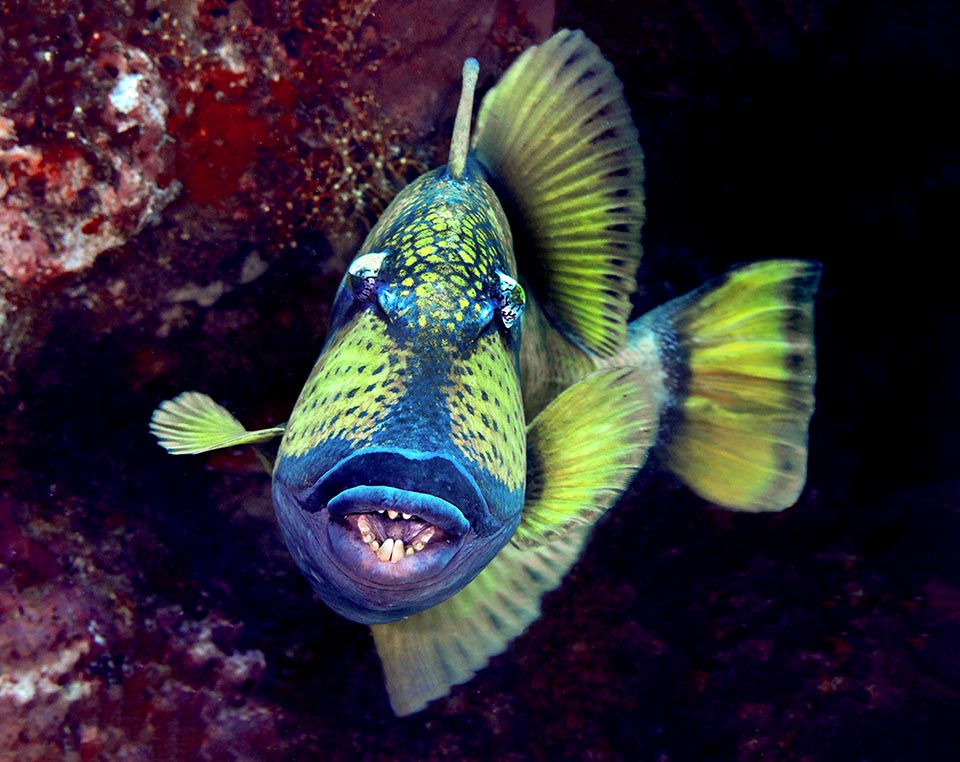
Even 75 cm long, here menacing with its erectile spine vertically blocked on the back, Balistoides viridescens is the largest extant triggerfish © Rafi Amar
The Titan triggerfish (Balistoides viridescens Bloch & Schneider, 1801) belongs to the class of Actinopterygii, the ray-finned fishes, to the order of Tetraodontiformes and to the family of Balistids Balistidae, the well known triggerfishes.
The name of the genus “Belistoides” comes from the Latin “balista” = crossbow, the same etymology of the genus Balistes, and from the suffix “-oides”, used in the old Greece for meaning “similar to”. In short, it is a fish similar to those of the genus Balistes.
The name of the species comes from the Latin “viridescens” = becoming green, with reference to the adult livery.
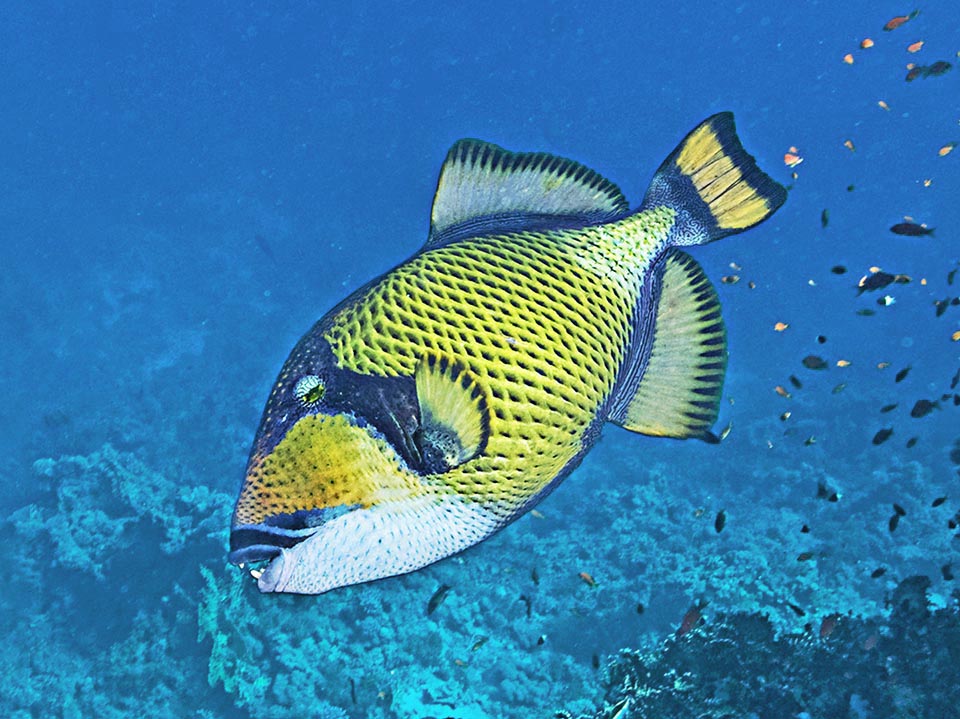
It has a very vast distribution in the tropical Indo-Pacific, from the Red Sea and African coasts up to Australia and to French Polynesia up to Pitcairn Islands © Gianni Neto
Zoogeography
It is present in the Indo-Pacific tropical waters. As an indication, we find it, along the African coast, from Mozambique to the Red Sea, to the islands Seychelles, Mauritius, Réunion, Maldives, India, Sri Lanka, Thailand, Australia, Indonesia, New Guinea, Micronesia, Philippines, Taiwan and China up to Japan.
Eastwards, it’s at home in Kiribati, Samoa, the Marquesas Islands and Tuamotu, but has not colonized the Hawaii. Southwards, it reaches Tonga and New Caledonia.
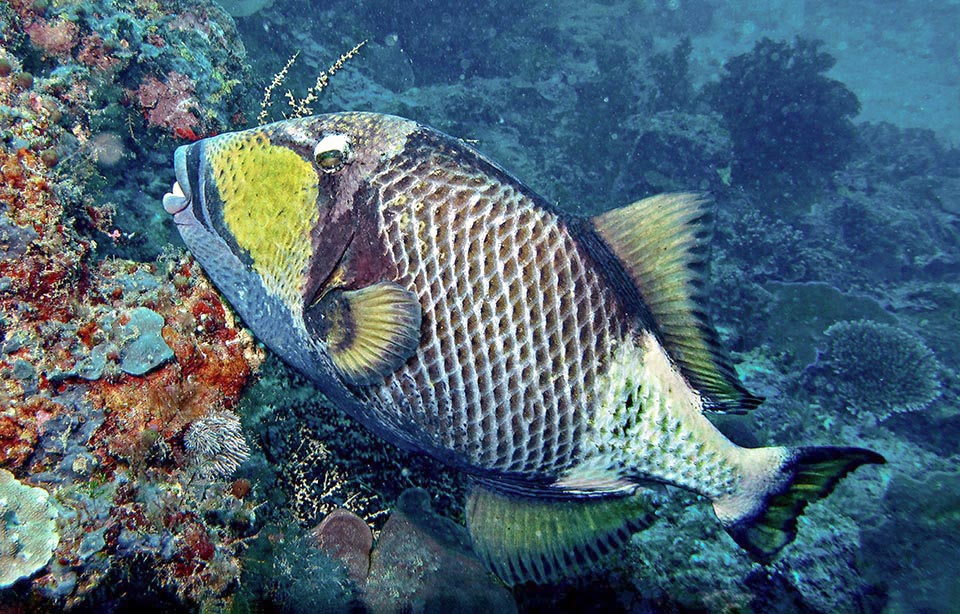
The body is protected by a solid covering of bony scales. They are scabrous with small spines facing forward near the caudal peduncle © Bernard Dupont
Ecology-Habitat
Balistoides viridescens lives inside the reef, in the still waters of the madreporic formations up to 50 m of depth.
Morpho-Physiology
With its 75 cm of length, it is the largest extant Balistidae The body is flat, ovoid, protected, like all triggerfishes by a solid coating of bony scales. These are scabrous with small spines bent forward close to the caudal peduncle.
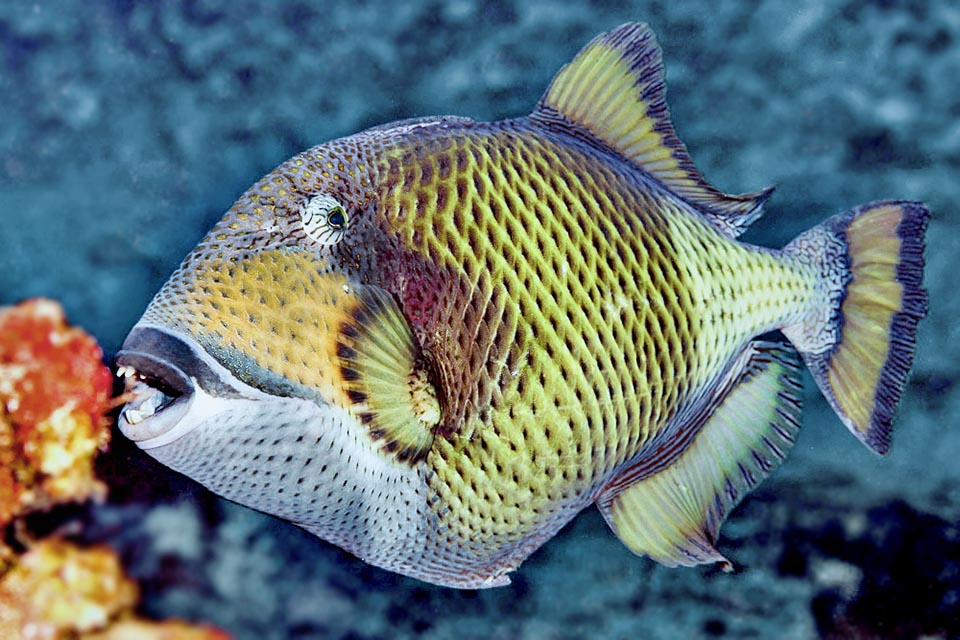
It swims in relatively shallow waters, without exceeding the depth of 50 m, eating crustaceans, mollusks, annelids, sea urchins and starfishes, including the ill-famed Acanthaster planci who devours the corals. On the one hand therefore protects the reef, but then happily scrumbles unscrupulous, the madrepores to eat their polyps © François Liber
On the back stands the typical erectile trigger formed by three spines, which the fish may block, for defence, in erect position. It keeps armed even when dead, and the first spine, long and sharp as a dagger, deters at first sight the aggressors.
The second dorsal fin counts 24-26 soft rays and is almost specular to the anal which has 22-24 of them.
The pectoral ones count 15-16 unarmed rays, the ventral are reduced to a spike and the caudal fin is rounded in the juveniles and almost truncated in the adults.
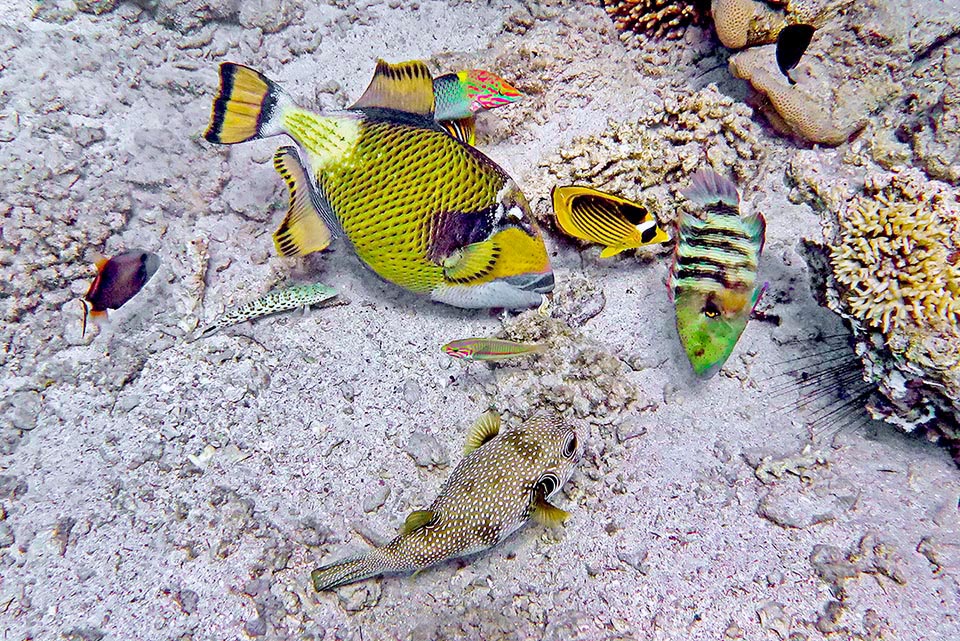
It has just destroyed one and has in its mouth the remains of an ill-fated mollusk. Around eight different species of fishes take advantage of leftovers © Gianemilio Rusconi
The mouth, robust, is armed by solid incisors useful for breaking the endoskeletons of the sea urchins, of the crustaceans and of the molluscs, not to forget the madrepores it crumbles without any effort for eating their polyps. But, if it is the case, it does not ignore also the easy preys, such as the tubeworms.
The livery is clear in the juveniles with a black dotting interesting the whole body but the under chin. From the eyes and the dorsal fin generate two dark zones, stronger in the adults, whilst the central part of the body colours of greenish yellow and the lips and under the chin become blue. The fins are brown-yellowish or reddish with dark edge.
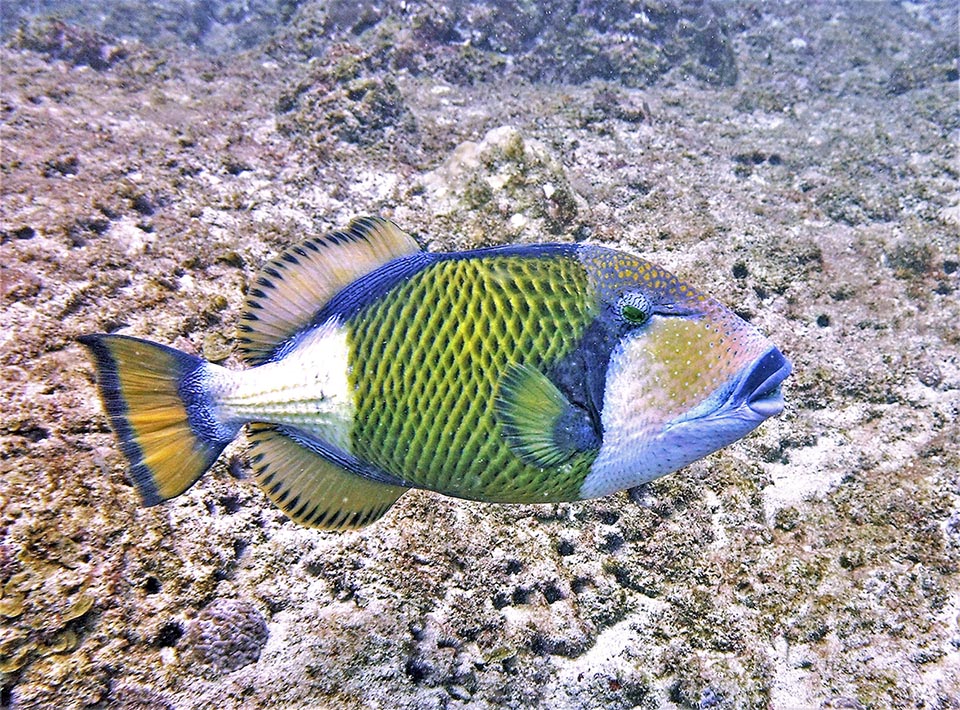
Balistoides viridescens is actually a peaceful fish, aggressive only during the breeding time when it surveys the nest dug in the sand. Casually fished, it is at times consumed by the fishermen, even if its meat is at ciguatera risk, an intoxication linked to the possible presence of poisonous organisms in their diet © Karine Marangon
Ethology-Reproductive Biology
When it crumbles the madrepores, the titan triggerfish reveals also to be charitable, as it is surrounded by small fishes who take advantage from the waste. It is not particularly aggressive, but during the reproductive time, till the hatching, the females keep the watch to the nest dug into the sand and do not hesitate in ferociously biting the intruders.
If caught in the nets, seen its size, the titan triggerfish is often consumed by the fishermen, careless of the risk of ciguatera, an intoxication linked to the possible presence of poisonous organisms in their diet.
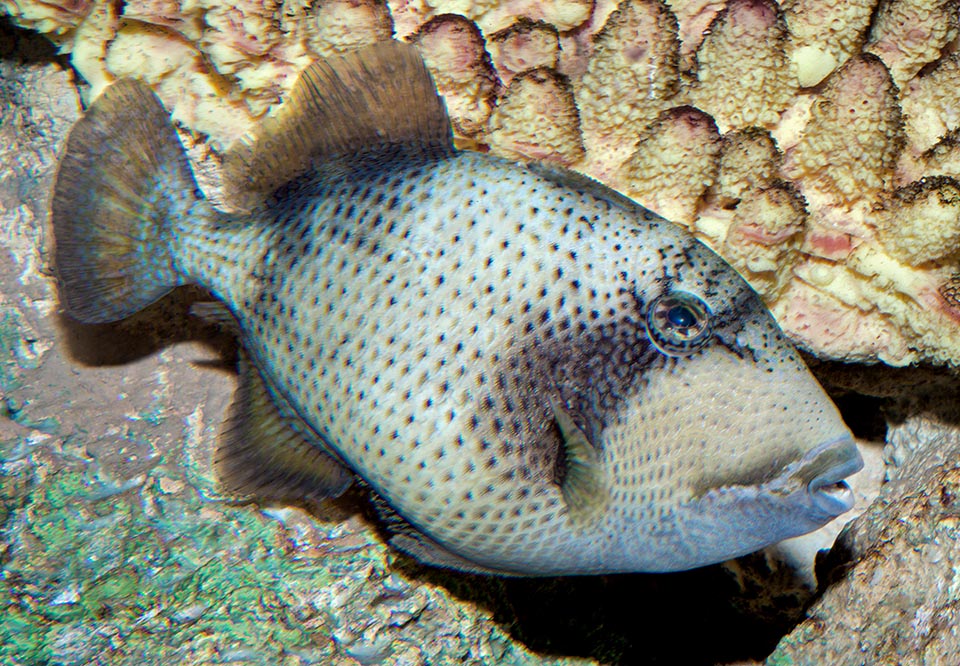
The juveniles’ livery is clear with a black mimetic dotting. The resilience is low, with a minimum doubling time of the populations of 4,5-14 years, and the fishing vulnerability index marks 50 on a scale of 100, but the Titan triggerfish appears in the IUCN Red List as “Least Concerned”, that is under minimum preoccupation © Giuseppe Mazza
In the IUCN Red List Balistoides viridescens is “Least Concern“, but the resilience is low, with a minimum doubling time of the populations of 4,5-14 years, and the fishing vulnerability index already marks 50 on a scale of 100.
Synonyms
Balistes viridescens Bloch & Schneider, 1801; Pseudobalistes viridescens Bloch & Schneider, 1801; Balistes brasiliensis Bloch & Schneider, 1801; Pachynathus nigromarginatus Tanaka, 1908; Balistes nigromarginatus Tanaka, 1908.
→ For general information about FISH please click here.
→ For general information about BONY FISH please click here
→ For general information about CARTILAGINOUS FISH please click here.
→ To appreciate the BIODIVERSITY of BONY FISH please click here.
→ To appreciate the BIODIVERSITY of CARTILAGINOUS FISH please click here.
